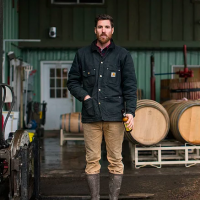View this post on Instagram
Watch: Waylon Lewis in a live conversation with Graham Markel, founder of Buona Notte Wines, about the craft of wine making and what really goes into the wine we are drinking:
Hey Elephant readers, it’s been awhile.
Seems to be a few more of you than there were last time I wrote an article. It must have been close to 10 years when I wrote about bikes, tomatoes, and those doggone corn plastic cups.
Waylon Lewis was just turning a young 55, I think. For some reason, he doesn’t seem to be getting any younger, just more handsome. Maybe it’s the vegan food and yoga, or maybe it’s clean, organic wine he’s been drinking every once in a blue moon. I don’t know much about being vegan or a whole lot about yoga (I can touch my toes, though), but…
I do know a little about wine.
I have a few things that I would like to share about wine with the Elephant audience that you may not know.
I do know that we should all be drinking wine that’s made mindfully and is still knock-your-toe-socks-off delicious.
It’s the holidays and I’m sure there is wine everywhere you look. So let’s throw in a little lesson as to what wine you should be drinking for the next few weeks with your loved ones.
What have you been drinking—just some fermented grapes, right?
Probably not.
There are a few things that are just not really talked about in the wine industry. At least, in my experience, it seems like news to most people when I talk to them about this.
It’s all the additional things that go into wine that is not mentioned. Of course almost all bottles say that the wine “contains sulfites,” but they don’t mention just how much sulfur is actually added, it can be, in certain cases, quite a lot.
There’s no mention that it may also contain added acid, added sugar, added tannins, and a multitude of other things…including fish guts.
In all honesty, in moderation, it doesn’t bother me. It’s one way to make delicious wine, and it’s totally up to the winemakers’ beliefs and choice. As a winemaker myself, I choose not to use more than a homeopathic, five to 10 parts per million of sulfur just before bottling. I don’t think I will ever add sugar or acid. And I pinky swear to never add tannins to my wine.
After all, these are all things that are naturally occurring in grapes. Grapes start to convert acid to sugar in the ripening process. Acid, tannins, and sugar are added during the winemaking process when a wine is imbalanced. If the grapes are picked early, or in a cold year when they haven’t produced enough sugar, then sugar is added. If the grapes are picked later, or in a hot year when they have a lot of sugar and are low in acid, then acid is added.
Okay, so what’s the big deal?
The sugar and acid that are added are processed ingredients. Walk through the supermarket in your local wine growing region during a cold harvest, and you might notice the sugar shelf looking a little bare. Stick your finger in the acid bin and it may remind you of the sour on a Sour Patch Kid—it’s the same acid.
I have a good, not great, palate at best, but I’m usually able to tell a wine that has had a large acid addition. The acid is always a little disjointed.
Sulfur is an amazing tool for winemakers, and is a wildly complex subject that I’m definitely not qualified to write about in detail. It would probably be quite boring for most of you anyway. However, it can be overused to the point that it does affect the final consumer—it may give you a headache just thinking about it.
One way is not necessarily better than the other. Some of my favorite wines in the world have had additions, and I hope they keep it that way. But: they just don’t mention it on the label.
I like to know what goes into the wine I’m drinking. I’m fairly sure if you’re reading Elephant you feel the same way. Wine is a living thing that, in my opinion, if it is made with some thought and is allowed to do its thing, can find a brilliant, balanced, outcome on its own.
There are a million other factors that go into choosing what bottle of wine you choose to drink on any given night. Most importantly, does it have an animal on the label? Is the animal cute? Even more, I know there’s a lot more to be said about how to mindfully pick a bottle of wine—what the fork is up with all the ladybugs? (If you guys like this article maybe I’ll come back and write about those ladybugs. Seriously.)
However, for now here are a few delicious wines that are made with deep thought and do not have anything added…except for a very small amount of sulfur.
I like to drink these wines with a big meal, prepared thoughtfully, with loved ones and soon to be loved ones.
Oh yeah, I almost forgot—these wines are made by up-and-coming winemakers putting their lives into doing something cool and different, letting the land and grapes speak for themselves. There is a lot of energy that goes into that, and it should be celebrated. It’s hard f*cking work!
If interested, you can purchase a bottle of Buona Notte wine at their website.
~~
 Share on bsky
Share on bsky



Read 0 comments and reply